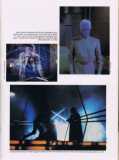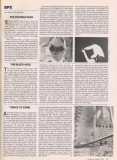The Disney Studios have toyed with science fiction sporadically over the years since their first foray into the genre with 20,000 Leagues Under the Sea. It was hoped that The Black Hole, a film based on an idea of the late Winston Hibler called Space Probe 1, would put Disney back into the forefront of SF-adventure film production. Though The Black Hole did not succeed as an SF-film, it has received recognition for the technical innovations developed at the studio to create the film's visual effects. While most of the effects depended on high tech computers, D.C. servomotors, complex miniature and optical effects, one of the most memorable illusions dates from the nineteenth century . . . even before the invention of film. The scene is pictured on p. 37: Dr. Alex Durant (Anthony Perkins) aboard the Palomino peering at and through a "holographic" projection of a large whirling vortex of glowing gas and dust surrounding an immense black hole. Unlike so many of the scenes in The Black Hole, this effect was created "in-camera" without the necessity of post-production opticals. The image of the glowing vortex is projected onto a piece of clear flat glass placed at a 45° angle between the camera and the actor. The camera sees the actor through the glass and a transparent image of the vortex reflected off the glass. You can get an idea of the effect by looking through a window and seeing your reflection and the scene outside the window at the same time. If you could control the intensity of the light on the outside scene and the reflection, you could make one image "brighter" than the other or one image "dissolve" into the other. The next time you visit the Haunted Mansion in Disneyland you can see the effect put to use for the scene of the ghosts seemingly appearing and disappearing at a banquet table and dancing next to it. Effects supervisor Peter Ellenshaw credits Ub Iwerks with the development of the technique at Disneyland, though Ellenshaw previously used in-camera effects in Disney's Darby O'Gill and the Little People, which makes great use of perspective tricks. The technique of reflecting a ghost-like image in glass dates from 1862. Henry Dircks, a civil engineer, and John Henry Pepper, a professor at London's Royal Polytechnic Institution, created the illusion "Pepper's Ghost" in a fashion similar to the black hole effect. The illusion was popular for years and played with any number of variations either for transformation effects or ghostly appearances. After the turn of the century, the technique moved from stage effects into the realm of movie magic.

